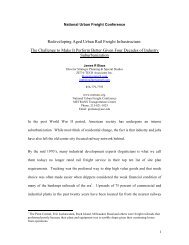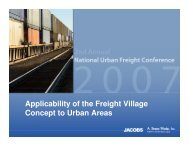Table of Tables - METRANS Transportation Center
Table of Tables - METRANS Transportation Center
Table of Tables - METRANS Transportation Center
Create successful ePaper yourself
Turn your PDF publications into a flip-book with our unique Google optimized e-Paper software.
Evaluating the Feasibility <strong>of</strong> Electrified Rail at the<br />
Port <strong>of</strong> LA/LB<br />
3.2 Overhead Caternary Retr<strong>of</strong>it Material and Installation Costs<br />
Conventional<br />
Third rail s ystems requiring a t-ground foundation a nd s ubstantial m etallic c onductors<br />
seemingly cost more for materials and installation than simply stringing overhead wires<br />
between distant poles for a cat ernary rail electrification system. The difference in cost<br />
however is not that great; due to the fact that contact between the overhead wire and the<br />
pantograph on t he l ocomotive i s not a s imple arrangement. T he mechanical cont act<br />
between the spring loaded pantograph and the hanging power wire is difficult to maintain<br />
due t o physical waves set up in the w ire. M ultiple pa ntographs pe r tr ain mitigate<br />
intermittent contacts. Maintaining a level power wire requires significant tension which<br />
for s imple s ystems limit s the s pacing <strong>of</strong> th e c aternary s upports. In order to space t he<br />
supports f urther apart a nd he nce i mprove economy, m odern e lectrified rail us es a t rue<br />
caternary a s a s upport f or t he pow er w ire m uch l ike a s uspension br idge supports a<br />
roadway. “Droppers” and “stitches” support the power line from the caternary as shown<br />
in the photo <strong>of</strong> the Acela, Boston to Washington train in Figure 3.<br />
Figure 3- Pantograph on the Acela Contacting Power Wire Supported from<br />
Overhead Caternary (“Messenger Wire”) by “Droppers”<br />
Early overhead caternary systems used DC transmission and DC traction motors similar<br />
to third rail s ystems; h owever, e ase <strong>of</strong> tr ansmission a nd t he a forementioned hi gher<br />
voltage c apacity ha s c aused A C t o be come t he pr evalent f orm <strong>of</strong> e lectrification f or<br />
overhead caternary rail electrification.<br />
7




